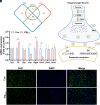PM2.5 exposure contributes to anxiety and depression-like behaviors via phenyl-containing compounds interfering with dopamine receptor
- PMID: 38739786
- PMCID: PMC11127009
- DOI: 10.1073/pnas.2319595121
PM2.5 exposure contributes to anxiety and depression-like behaviors via phenyl-containing compounds interfering with dopamine receptor
Abstract
As a global problem, fine particulate matter (PM2.5) really needs local fixes. Considering the increasing epidemiological relevance to anxiety and depression but inconsistent toxicological results, the most important question is to clarify whether and how PM2.5 causally contributes to these mental disorders and which components are the most dangerous for crucial mitigation in a particular place. In the present study, we chronically subjected male mice to a real-world PM2.5 exposure system throughout the winter heating period in a coal combustion area and revealed that PM2.5 caused anxiety and depression-like behaviors in adults such as restricted activity, diminished exploratory interest, enhanced repetitive stereotypy, and elevated acquired immobility, through behavioral tests including open field, elevated plus maze, marble-burying, and forced swimming tests. Importantly, we found that dopamine signaling was perturbed using mRNA transcriptional profile and bioinformatics analysis, with Drd1 as a potential target. Subsequently, we developed the Drd1 expression-directed multifraction isolating and nontarget identifying framework and identified a total of 209 compounds in PM2.5 organic extracts capable of reducing Drd1 expression. Furthermore, by applying hierarchical characteristic fragment analysis and molecular docking and dynamics simulation, we clarified that phenyl-containing compounds competitively bound to DRD1 and interfered with dopamine signaling, thereby contributing to mental disorders. Taken together, this work provides experimental evidence for researchers and clinicians to identify hazardous factors in PM2.5 and prevent adverse health outcomes and for local governments and municipalities to control source emissions for diminishing specific disease burdens.
Keywords: PM2.5 exposure; anxiety and depression-like behavior; dopamine signaling system; organic component; toxicogenic structure.
Conflict of interest statement
Competing interests statement:The authors declare no competing interest.
Figures







References
-
- Ho H. C., et al. , Spatiotemporal influence of temperature, air quality, and urban environment on cause-specific mortality during hazy days. Environ. Int. 112, 10–22 (2018). - PubMed
Publication types
MeSH terms
Substances
Grants and funding
LinkOut - more resources
Full Text Sources
Medical
Research Materials

